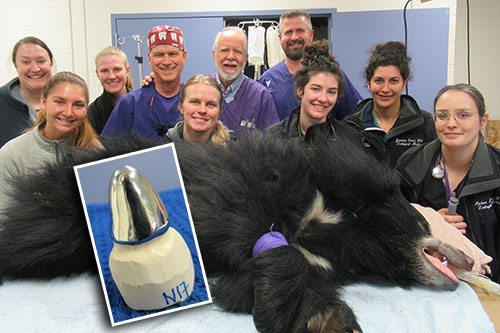Performing a Root Canal and Placing a Crown on a “Dancing” Bear’s Canine Tooth
By Dr. James Carpenter
 Tess, a 3-year-old, 200 lb sloth bear (Melursus ursinus) housed at the Sunset Zoo, was immobilized on Aug. 12, 2022, for a scheduled root canal on the lower right canine tooth with the Zoological Medicine Service (Drs. Alison Jeffrey and Jim Carpenter, along with students on the clinical rotation), the Anesthesia Service (Drs. Morgan Murphy and John Whittaker), and with our zoological veterinary dentist, Dr. Doug Winter. The root canal was successfully completed, and an impression mold was made for a crown for the fractured tooth. Because of other concurrent medical issues with Tess, Dr. Clay Hallman (Diagnostic Imaging and Radiology Service), also performed an abdominal ultrasound scan.
Tess, a 3-year-old, 200 lb sloth bear (Melursus ursinus) housed at the Sunset Zoo, was immobilized on Aug. 12, 2022, for a scheduled root canal on the lower right canine tooth with the Zoological Medicine Service (Drs. Alison Jeffrey and Jim Carpenter, along with students on the clinical rotation), the Anesthesia Service (Drs. Morgan Murphy and John Whittaker), and with our zoological veterinary dentist, Dr. Doug Winter. The root canal was successfully completed, and an impression mold was made for a crown for the fractured tooth. Because of other concurrent medical issues with Tess, Dr. Clay Hallman (Diagnostic Imaging and Radiology Service), also performed an abdominal ultrasound scan.
 On Jan. 23, 2023, Tess was again immobilized by the Zoological Medicine Service. Dr. Winter (pictured on the right) placed a dental crown (silver) on the canine. The anesthesia, examination, and placement of the crown were all done successfully. The crown was made of a metal alloy, a resistant material which should allow it to stand up to a lot of potential wear and damage for many years. The sloth bear is one of the most popular animals at Manhattan’s Sunset Zoo, and is one of the first bears ever to receive a dental crown.
On Jan. 23, 2023, Tess was again immobilized by the Zoological Medicine Service. Dr. Winter (pictured on the right) placed a dental crown (silver) on the canine. The anesthesia, examination, and placement of the crown were all done successfully. The crown was made of a metal alloy, a resistant material which should allow it to stand up to a lot of potential wear and damage for many years. The sloth bear is one of the most popular animals at Manhattan’s Sunset Zoo, and is one of the first bears ever to receive a dental crown.
It should be noted that the sloth bear is one of eight bear species in the world, with an estimated population of 20,000 remaining in the wild, classifying them as a “vulnerable” species (i.e., very likely to be declared endangered) by the International Union for Conservation of Nature. This species received its name of “sloth bear” for its long, thick claws and unusual teeth. Therefore, some thought that it was related to the true sloth. The sloth bear feeds mainly on ants and termites, thanks to the unique long palate and lower lip that allows them to suck up their meals.
Unfortunately, due to a somewhat docile nature and smaller stature, this type of bear has been used in ways that may not support current animal welfare objectives. Historically, in certain parts of the world, sloth bears were treated in ways that may classify as unfavorable or even cruel by contemporary animal care standards. This management was a practice that was thought to have taken place over many centuries, perhaps for a period of approximately 400 years. In these settings and in some parts of the world female sloth bears were hunted by Qalanders, an itinerant group of performers (like gypsies) in India and Pakistan. Baby/young bears were then taken from their regular environment and trained from a young age for entertainment purposes, somewhat like circus animals.
In these settings and in an effort to further domesticate these animals, the canine teeth and claws of these bears were removed and a ring was placed through the muzzle, which was tugged on by the indigenous folks to encourage the bears to dance. Often referred to as “dancing bears,” sloth bears were known to be easily trained for the entertainment of royal courts and street performers. In 1996, there were still more than 1200 dancing bears, although since then, about half have been rescued.
Fortunately, this is a practice that is rare in today’s world. Tess is an example of the standard by which most sloth bears live in the United States currently. With the excellent care provided by Sunset Zoo and the outstanding veterinary health care team at K-State, animal care and management is held to a very high standard. We look forward to continued care for Tess for many years to come.